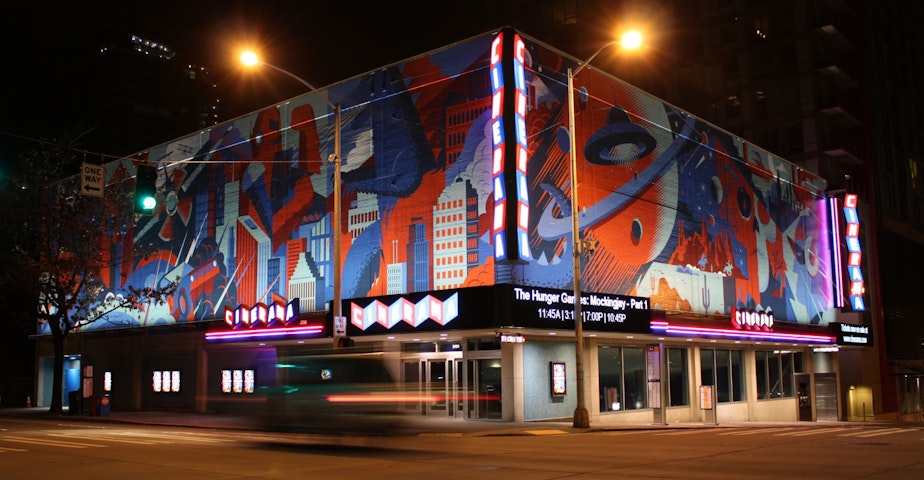Paul Allen's big-money legacy haunts the Seattle arts scene

In February 2020, Vulcan, Paul Allen’s company, announced the vibrant Cinerama theater downtown would be closing for renovations, with updates like a new carpet and kitchen equipment. Then, Vulcan announced it was completely closing its arts and entertainment division.
That meant the Cinerama would be closed, as they said, “for the foreseeable future.”
It never reopened.
Until now.
W
hen longtime Seattleites think of the Cinerama, they remember blockbusters and chocolate popcorn. Or the displays of film costumes lining the lobby that belonged to the the theater's owner, Paul Allen. The theater was just cool, in a way others weren’t. When you went to see a movie there, it felt like an experience.
For the last three years the Cinerama has been closed. But in May of this year, the Seattle International Film Festival, aka SIFF, announced they had purchased the theater.
"Chapter one was the acquisition, and chapter two will be a lot of fun working with our teams here and also with the community to the gearing up to reawaken her," explained Tom Mara, SIFF's executive director.
And yes, he promised to bring the chocolate popcorn back. Although the actual name of the theater, Cinerama, will have to change due to licensing issues.
But Vulcan Arts + Entertainment wasn’t just the Cinerama. It included the Seattle Art Fair, two local museums, and an entire film production company.
Sponsored
And those aren’t the only arts spaces Paul Allen invested in. There’s also the Seattle Museum of Pop Culture and Upstream Music Fest.
Plus, he bought a museum's worth of art. In a recent Christie’s fine art auction, his estate broke records, selling $1.5 billion worth of works from his personal collection.
Allen’s investments supported a lot of local arts projects as they were getting started.
But, he’s not here anymore. In 2018, Paul Allen died, leaving behind billions of dollars.
And while his foundation has continued to make contributions like the $10 million they distributed to arts organizations statewide through ArtsFund, and his estate donated thousands of pieces recently donated to MoPop, the looming question in the wake of Allen’s presence in the local arts community is: What happens now?
Sponsored
Allen’s legacy in local arts is complicated. Having a billionaire art patron who in a lot of ways decided what got funding and what didn’t will obviously leave some people feeling burned.
But Allen was known for his innovation. He took chances with bold ideas like the Seattle Art Fair and Upstream Music Festival. Whether these ideas panned out or not, he always seemed willing to take a chance at moving the needle.
"I was just looking at what sort of art enterprises have happened in the past 20 years. And I noticed that the major ones are coming from decisions made by Paul Allen," explained Charles Mudede.
Mudede writes about books, film and music for The Stranger. He recently wrote a piece called “Seattle's Big-Art Culture Has No Future After the Death of Paul Allen.”
"We just haven't had the kind of adventure in arts events and institution creation that came through Paul Allen, and his sort of civic attitude," Mudede said. "There's a problem with having a billionaire at the center of this kind of creativity and this kind of investment, because if he's gone, there's nothing else there to fill in the gap."
Sponsored
Seattle Times art economy reporter Margo Vansynghel agreed that Allen played a major role in the local arts economy.
"Every time I write an article that's about the Seattle Art Fair or about the Cinerama, I'm like, 'Well, this is the last time that I'll be thinking about Paul Allen for a little while,'" Vansynghel said. "And then like, two weeks later, I have to think about Paul Allen again."
Vansynghel previously reported on the impact of Allen's art collection on local artists.
She said that there are other organizations that offer some art funding, including the Allen foundation, which still exists.
But there was something unique about how Allen did it, "this kind of startup culture," Vansynghel explained, a "move fast and break things" philosophy.
Sponsored
"He did pull the plug pretty quickly on some things," she noted, "but he did try stuff."
Mudede said more arts funding should come from city government.
"As we look at ourselves as a city, and we see the kind of wealth that we have, we're still caught in this old discussion about budget cuts and tightening our belts," he explained. "To me, the question is, will the city really step up?"
Paul Allen may be gone, but the Cinerama lives on.
Sponsored
As soon as SIFF announced they acquired the building, both the city and King County stepped up with close to $2 million in funding to support the theater.
And, through his Paul G. Allen Foundation, and his estate, Allen has still left his mark.
His estate sold the Cinerama to SIFF for $4.5 million, when estimates show the space is actually worth more like $15.5 million.
But with the shift away from theaters to streaming, combined with the ongoing Hollywood writers' and actors' strikes, the question remains: Can the Cinerama rise from the dead and live again?
Correction notice, 12:41 p.m. on Wednesday, 08/30/23: A previous version of this story incorrectly stated that the Paul G. Allen foundation was responsible for the sale of the Cinerama and had donated artifacts to the Museum of Pop Culture. The Paul G. Allen association is a separate entity from the Allen estate, and was not responsible for these actions. The Paul Allen Estate is.





